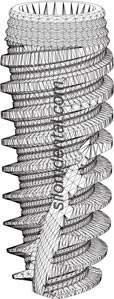 |
|








NobelActive™ Implant
A new direction for Implants
language |
l |
THAI |
|
|
The self-condensing abilities of NobelActive™ implants
deliver advantages in all types of bone and in compromised situations, especially in softer bone.
NobelActive™ implants
don't cut through bone like conventional implants, they gently press through it like a corkscrew.
This bone condensing capability delivers high initial stability. The narrow neck is designed to
preserve marginal bone and promote long-lasting soft tissue stability.
The self-drilling ability of NobelActive™ implants
allows it to be inserted into sites prepared to a reduced depth. This is useful where sites are close to vital anatomical structures:
the mandibular nerve canal or the maxillary sinus, and nose cavity for instance.
This means you can be confident of accurate placement while having a minimally invasive procedure.
The unique combination of design features of NobelActive™ implants
is derived from thorough investigation into the bio-mechanical dynamics of hard and soft tissues surrounding dental implants.
|
|
NobelActive™ offers unique advantages
|
||||||||||
|
|
high initial stability, even in compromised bone situations & redirecting capability for optimal placement The expanding tapered body with double variable thread design and apical drilling blades delivers high initial stability and enables experienced clinicians to actively change implant direction for optimal restorative position. |
||||||||||
|
|
bone condensing property The expanding tapered body and double variable thread design of NobelActive™ produces a gradual bone-condensing property, illustrated here using a checkerboard background representing bone. |
||||||||||
|
|
NobelActive™ implant design
|
HOME
l SERVICE
l DENTISTS
l TECHNOLOGY
l FACILITIES
l ABOUT US
l SITE MAP
PROMOTION
l PRICE&DURATION
l CONSULTATION
l FAQ
l LINKS
l MAP
l TESTIMONIALS
l OUR LAB
l RESOURCES
DENTAL BRACES
l LASER TEETH WHITENING
l IMPLANT DENTISTRY
l ENDODONTICS
l OPERATIVE DENTISTRY
l SEDATION DENTISTRY
COSMETIC DENTISTRY
l PROSTHODONTICS
l PERIODONTICS
l ORAL SURGERY
l PAEDODONTICS
l GP & ORAL EXAM
l OCCLUSION
DENTAL OFFICE
l DENTAL CLINIC
l COSMETIC DENTISTRY
l COSMETIC DENTIST
l TEETH BLEACHING
l TOOTH WHITENING
DENTAL CROWNS
l DENTAL IMPLANTS
l DENTAL TREATMENT
l DENTAL IMPLANT
............................................................................................................................. Copyright© 2004 SILOM DENTAL BUILDING. All Rights Reserved.
Local Call : 0 2636 9092-5, International Call : (+) 66 2636 9091, (+) 66 2636 9097
e-mail :silomdental@silomdental.com
Dental Implant, Dental Implants, Implant, Dental Implant Bangkok, Dental Implants Thailand, Implant Dental Center, Implant Bangkok Thailand





